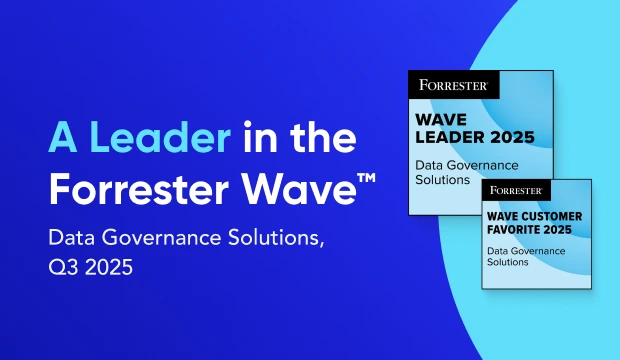What are the key features of a modern data catalog? #
Summarize and analyze this article with 👉 🔮 Google AI Mode or 💬 ChatGPT or 🔍 Perplexity or 🤖 Claude or 🐦 Grok (X) .
Modern data catalogs go beyond basic asset discovery to provide comprehensive data intelligence:
- Automated discovery: Scans databases, data lakes, and warehouses to inventory assets without manual effort.
- Rich metadata management: Captures technical, business, and operational metadata, including schemas, descriptions, and usage patterns.
- Data lineage tracking: Visualizes how data flows through systems, transformations, and consumption points.
- Collaborative annotations: Enables teams to add context, ratings, and documentation directly within the catalog.
- Smart search & filtering: Uses AI-powered search with natural language queries and faceted filtering.
- Access control integration: Connects with existing security frameworks to enforce data permissions.
- Quality monitoring: Tracks data freshness, completeness, and accuracy metrics.
- API-first architecture: Supports integration with existing data stacks and workflow automation.
These features transform data catalogs from static inventories into active governance platforms that adapt to modern data architectures.
Why is a data catalog essential in 2025? #
Data complexity has reached unprecedented levels, making catalogs critical for organizational success:
- Scale crisis: Organizations manage 10x more data sources than five years ago, with 68% of data teams reporting discovery bottlenecks.
- Compliance pressure: Regulations like GDPR, CCPA, and emerging AI governance frameworks require precise data tracking and lineage documentation.
- AI readiness: 85% of AI models may fail of the time due to poor data quality and discoverability issues.
- Cost optimization: Companies waste $12.9 million annually on duplicated data efforts and abandoned projects.
- Remote work impact: Distributed teams need self-service access to trusted data without constant expert consultation.
- Real-time decisions: Business velocity demands instant access to reliable, contextual data assets.
According to Gartner’s 2025 predictions, organizations with mature data catalogs achieve 3x faster time-to-insight and 40% reduction in data preparation overhead. The catalog becomes the central nervous system connecting data producers, consumers, and governance stakeholders across the enterprise.
How does a data catalog work? #
Data catalogs operate through automated discovery, intelligent classification, and continuous enrichment:
- Discovery phase: Crawlers scan connected systems—databases, APIs, files, streaming platforms—extracting schema information, sample data, and usage statistics. This happens on scheduled intervals without disrupting operations.
- Classification engine: AI algorithms analyze discovered assets to infer data types, sensitivity levels, and business domains. Pattern recognition identifies PII, financial data, and other regulated content automatically.
- Metadata enrichment: The system combines technical metadata (schemas, statistics) with business context (descriptions, ownership, quality scores) and operational insights (access patterns, performance metrics).
- Lineage construction: By monitoring data movement and transformations, catalogs build comprehensive dependency graphs showing upstream sources and downstream consumers.
- User interface: Search, browse, and collaboration features allow users to discover assets, understand context, request access, and contribute knowledge back to the catalog.
- Integration layer: APIs and webhooks connect catalogs to data pipelines, BI tools, and governance workflows, enabling automated policy enforcement and impact analysis.
How do I choose the right data catalog tool? #
Selecting a data catalog requires systematic evaluation across technical architecture, governance capabilities, and operational requirements. Use this comprehensive checklist to guide your decision:
| Evaluation Category | Critical Requirements | Assessment Criteria |
|---|---|---|
| Technical Architecture | Connector Ecosystem | □ Supports 100+ native connectors □ Includes Snowflake, Databricks, dbt, Airflow □ Custom API integration capability |
| Real-Time Lineage | □ Column-level lineage tracking □ Query-level monitoring □ Multi-hop dependency visualization |
|
| Performance & Scale | □ Handles 1M+ assets □ Sub-second search response □ 1000+ concurrent users |
|
| Governance & Compliance | Policy Engine | □ Automated policy enforcement □ Custom validation rules □ Audit logging with tamper-proof storage |
| Data Classification | □ ML-powered PII detection (95%+ accuracy) □ Automated sensitivity tagging □ Regulatory compliance templates |
|
| Access Management | □ Self-service access requests □ Approval workflows □ Time-limited permissions |
|
| Operational Excellence | Metadata Management | □ API-first architecture □ Metadata versioning □ Incremental updates without rebuilds |
| User Experience | □ Natural language search □ Business-user-friendly interface □ Collaborative annotation features |
|
| Integration Depth | □ Native workflow tool embedding □ BI tool integration □ Event-driven automation |
Implementation Readiness Assessment:
- Proof-of-concept timeline: Can you deploy and see value within 2-4 weeks?
- Change management support: Does the vendor provide adoption training and best practices?
- Multi-region compliance: Does the solution support data residency requirements?
Teams that need active metadata, lineage-driven automations, and bias detection often layer a managed platform such as Atlan over existing data stores, skipping months of custom integration work.
Which data catalog examples or vendors should I know? #
Understanding the data catalog landscape helps identify the right architectural approach and feature priorities for your organization:
Common deployment architectures: Finding your fit
When considering a data catalog, the underlying deployment architecture significantly impacts its integration, scalability, and security posture. Here are the primary models you’ll encounter:
- Cloud-native catalogs: Best for cloud-first strategies and modern data stacks, offering serverless scaling and native integration with cloud data warehouses and lakes.
- Hybrid enterprise platforms: Ideal for large organizations with distributed environments, supporting both cloud and on-premises deployments with robust security and compliance.
- Lakehouse-integrated Solutions: Embedded within data lakehouse platforms for unified governance of structured and unstructured data, including ML model tracking.
- Open-source frameworks: Provide extensibility and customization but require significant technical investment for deployment and maintenance.
- Specialized active metadata platforms: Focus on real-time metadata, automated lineage, and collaborative governance, optimized for data team productivity.
Beyond Architecture: Key technical differentiators to evaluate
Once you’ve considered the architectural fit, delve into these technical factors to truly differentiate between vendor offerings:
- Metadata collection depth: Passive scanning vs. active monitoring of data pipelines.
- Lineage accuracy & detail: Schema-based inference vs. query-level tracking or code parsing for precise data flow visualization.
- Integration prowess: Surface-level APIs vs. deep embedding in data workflow tools for seamless operationalization.
- User experience (UX) philosophy: Technical-first interfaces vs. business-user-friendly collaboration features.
- Automation & AI sophistication: Manual curation vs. AI-powered classification and policy enforcement.
For an in-depth analysis of leading solutions and strategic implementation guidance, refer to industry reports such as Forrester’s Q3 2024 Wave report on data catalog solutions. Recognized as a leader by Forrester, Atlan helps leading data teams unlock significant value through active metadata and lineage-driven automations. It integrates seamlessly with existing data stores, often eliminating months of custom integration effort.
What pitfalls derail data-catalog projects? #
Common implementation failures stem from organizational and technical missteps that can be avoided with proper planning:

What pitfalls derail data-catalog projects? - Image by Atlan.
Success requires treating data catalog implementation as a strategic transformation initiative with dedicated resources and clear governance frameworks.
How does AI enhance data catalog capabilities? #
AI transforms data catalogs from passive repositories into intelligent, proactive governance platforms:
- Automated Classification: ML algorithms analyze data patterns to automatically tag sensitive information and business domains
- Smart Recommendations: AI suggests relevant datasets based on user roles and project context, reducing discovery time
- Natural Language Processing: Users can search using business terms rather than technical schema names
- Anomaly Detection: Continuous monitoring identifies unusual data patterns or access behaviors
- Automated Documentation: AI generates human-readable descriptions by analyzing schemas and usage patterns
These capabilities align with emerging AI governance frameworks like the NIST AI Risk Management Framework, emphasizing transparency and accountability.
Modern organizations need catalogs that combine human expertise with AI automation. Atlan’s active metadata platform exemplifies this approach, providing intelligent discovery while maintaining human oversight and collaboration. This balance ensures catalogs remain trustworthy and actionable as AI capabilities continue to evolve.
Real customers, real stories: Modern data catalog in action #

Modernized data stack and launched new products faster while safeguarding sensitive data
“Austin Capital Bank has embraced Atlan as their Active Metadata Management solution to modernize their data stack and enhance data governance. Ian Bass, Head of Data & Analytics, highlighted, ‘We needed a tool for data governance… an interface built on top of Snowflake to easily see who has access to what.’ With Atlan, they launched new products with unprecedented speed while ensuring sensitive data is protected through advanced masking policies.”

Ian Bass, Head of Data & Analytics
Austin Capital Bank
🎧 Listen to podcast: Austin Capital Bank From Data Chaos to Data Confidence
See how Atlan automates glossary, lineage & tagging.
Book a Personalized Demo →
53 % less engineering workload and 20 % higher data-user satisfaction
“Kiwi.com has transformed its data governance by consolidating thousands of data assets into 58 discoverable data products using Atlan. ‘Atlan reduced our central engineering workload by 53 % and improved data user satisfaction by 20 %,’ Kiwi.com shared. Atlan’s intuitive interface streamlines access to essential information like ownership, contracts, and data quality issues, driving efficient governance across teams.”
Data Team
Kiwi.com
🎧 Listen to podcast: How Kiwi.com Unified Its Stack with Atlan

One trusted home for every KPI and dashboard
“Contentsquare relies on Atlan to power its data governance and support Business Intelligence efforts. Otavio Leite Bastos, Global Data Governance Lead, explained, ‘Atlan is the home for every KPI and dashboard, making data simple and trustworthy.’ With Atlan’s integration with Monte Carlo, Contentsquare has improved data quality communication across stakeholders, ensuring effective governance across their entire data estate.”

Otavio Leite Bastos, Global Data Governance Lead
Contentsquare
🎧 Listen to podcast: Contentsquare’s Data Renaissance with Atlan
Ready to unlock your data’s full potential? #
In 2025, a modern data catalog is vital for any data-driven organization. It drives discovery, guarantees compliance, and speeds up analytics with smart governance and AI-powered insights. Achieve this by selecting the ideal platform and fostering a culture of data stewardship.
Discover how a modern data catalog drives real results
Book a Personalized Demo →FAQs about data catalogs #
How long does it take to implement a catalog? #
Most organizations see initial value within 2-4 weeks for basic discovery features. Full implementation with comprehensive lineage, governance workflows, and user adoption typically takes 3-6 months. Cloud-native solutions generally deploy faster than on-premises alternatives.
Do small companies need a data catalog? #
Yes, especially as data volumes and regulatory requirements grow. Small companies benefit from simplified catalog solutions that focus on discovery and basic governance. Starting early prevents technical debt and scales more effectively than retrofitting governance later.
How is a catalog different from a data dictionary? #
Data dictionaries are static documentation of database schemas and field definitions. Data catalogs are dynamic, searchable platforms that include dictionaries plus lineage, usage metrics, collaboration features, and automated discovery across all data assets.
Who owns the catalog after rollout? #
Successful catalogs require shared ownership between IT (technical maintenance), data governance teams (policy enforcement), and business users (content contribution). Many organizations establish a center of excellence with representatives from each stakeholder group.
How do you measure catalog ROI? #
Key metrics include time-to-discovery reduction, duplicate dataset elimination, compliance audit efficiency, user adoption rates, and data quality improvement. Most organizations report 20-40% reduction in data preparation time within the first year.
What security features should a catalog include? #
Essential security features include integration with existing identity providers, role-based access controls, audit logging, data masking capabilities, and encryption for metadata storage. The catalog should enforce the same security policies as underlying data systems.














